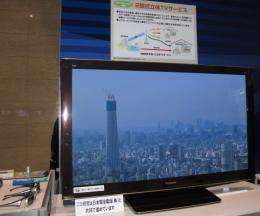May 30, 2011 report
Japanese public broadcasting group highlights two new television technology innovations

(PhysOrg.com) -- NHK Science and Technology Research Laboratories, the research arm of Japan’s NHK public television company, recently held its annual open house, which serves to show off the latest innovations in television and digital media. This year's event, in conjunction with Nippon Telephone and Telegraph, highlighted both a new way to transmit 3-D content and a way to broadcast animation in a more personal way.
The new 3-D technology involves sending signals for the left and right eyes separately; one over a communication line, the other over airwaves. The end result, when combined, is full HD equivalent video for both eyes, as opposed to the current 50% video now in use in Japan, where data is compressed before transmission. To sync the dual signals, a time stamp is embedded in both signals and a processor on the receiver ensures the signals arrive at the viewer’s eyes at exactly the same time. The idea was presented as part of a new concept STRL is working on called Hybridcast, where video content and supporting data are sent simultaneously to both a television service and a computer such as an iPad; allowing content providers to supply backing material to a device such as an iPad while video plays on the television.
Also, in a completely unrelated technological innovation, STRL showed off what it calls, Interactive IP rendering; which doesn’t even come close to describing what it is; and that is, a technique for marrying animated characters to the environment in which they "live." Which is another way of saying, they live in a box, instead of on a two dimensional screen. Thus, when the box (the television screen) is physically turned onto its side, the animated characters on screen react by sliding sideways down the slope created, till they crash into the edge. The technology, similar to the effect created when watching movies on an iPad when it is physically turned, goes one step further by adding a 3-D component and by making the content “aware” of what is happening and reacting to it. By combining the effect with realistic 3-D animation, the characters onscreen are also able to fall forward or backward, etc., if the screen is tilted as such.
To achieve its startling effect, the IP rendering method uses a technology it calls ray reproduction to recreate the way light is represented to the viewer, i.e. in a more natural, real world way.
This year’s open house, the 65th, was themed, “Experience the Future of Digital Broadcasting” and though muted by the ongoing recovery efforts due to the earthquake and tsunami still deeply affecting the country; the event was still clearly a success judging by demonstrations of such innovative technology.
More information:
via Techon
© 2010 PhysOrg.com

















